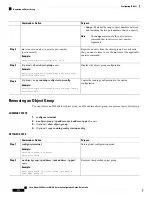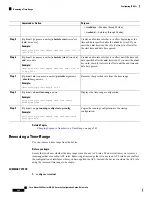
• For quality of service, ACL, or TCAM carving configuration on Cisco Nexus Series switches with -R
series line cards, see the
Cisco Nexus 3600 NX-OS Quality of Service Configuration Guide, Release 7.x
for more information.
• The non-atomic update either drops or permits all the traffic. By default, the non-atomic update drops
all the traffic until the ACL update completes. The non-atomic ACL update behavior can be controlled
using the
hardware access-list update default-result permit
CLI command. This CLI works only for
physical ports. See the following example:
hardware access-list update default-result permit
=> #Allows all the traffic during
ACL updates. There may be < 10secs traffic drop.
no hardware access-list update default-result permit
=> #This is the default behavior.
It denies all the traffic during ACL updates.
• The atomic ACL update is not supported on Cisco Nexus -R series line cards, but the non-atomic update
hardware access-list update default-result
is supported on Cisco Nexus -R series line cards.
Carving a TCAM Region
Before configuring the system ACLs, carve the TCAM region first. Note that for configuring the ACLs less
than 1k, you do not need to carve the TCAM region. See the
Configuring ACL TCAM Region Sizes, on page
section for more information.
Beginning with Cisco NX-OS Release 7.0(3)F3(4) or a later release, you can configure PACL IPv4, RACL
IPv4, and RACL IPv6 beyond 12k.
Note
Configuring System ACLs
After an IPv4 ACL is created, configure the system ACL.
Before you begin
Create an IPv4 ACL on the device. See
Creating an IP ACL, on page 233
for more information.
SUMMARY STEPS
1.
config t
2.
system acl
3.
ip port access-group
<
pacl name
>
in
DETAILED STEPS
Purpose
Command or Action
Enters the configuration mode.
config t
Step 1
Configures the system ACL.
system acl
Step 2
Cisco Nexus 9000 Series NX-OS Security Configuration Guide, Release 9.x
271
Configuring IP ACLs
Carving a TCAM Region






























